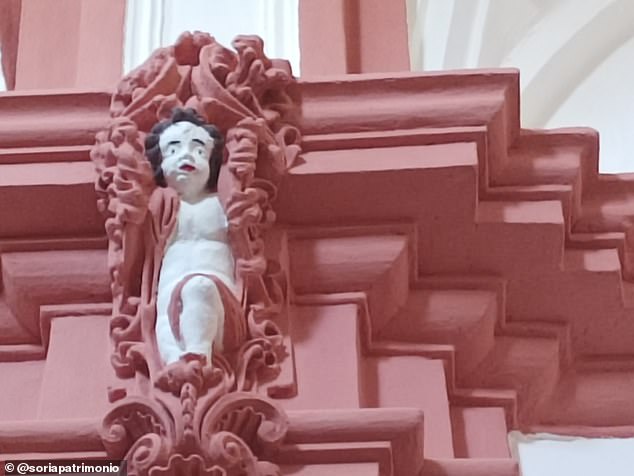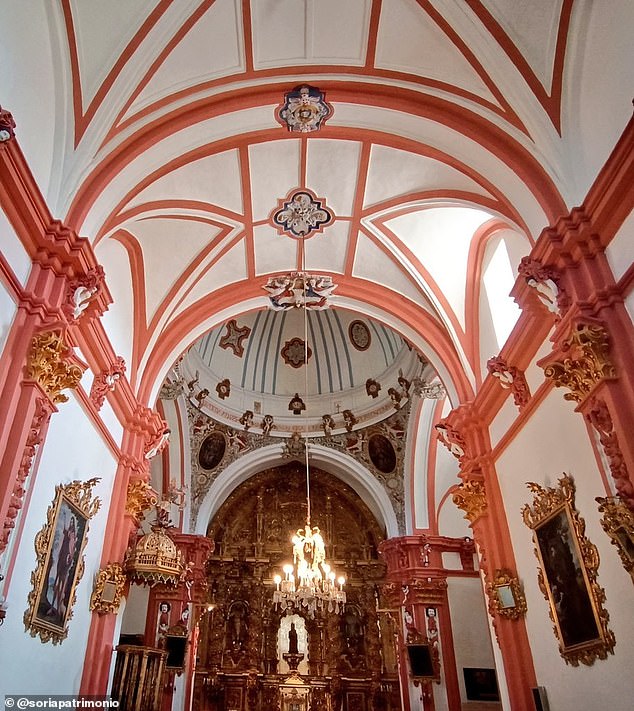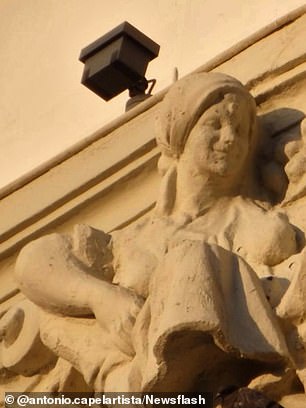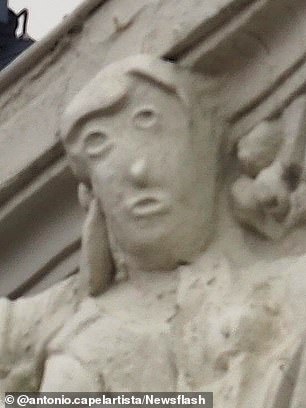Sculptures are mocked after ‘disastrous’ restoration left historic cherubs looking like ‘startled’ cartoon figures at 300-year-old Spanish church
A ‘disastrous’ restoration of historic cherub statues in Spain has been met with derision and outrage, with experts branding the ‘cartoonish’ restoration an ‘attack on heritage’.
Several decorations in the Ermita de Nuestra Señora del Mirón in Soria, northeast of Madrid, were crudely repainted in a striking white, with simple facial features and bright red lips. They stood out against the richly decorated statues nearby.
Conservationists called the cherubim’s renovation “disastrous” and “disrespectful” to the historic church and local heritage.
Francisco Manuel Espejo, president of the Spanish Association of Conservators and Restorers, said: ‘Those eyes and the painted lips really catch your attention.
“This is not just a failed restoration, it is an attack on our heritage.”
Spanish media compared the failed job to the famous 2012 restoration of ‘Ecce Homo’, which was mockingly called ‘Monkey Christ’ at the time.
The renovation work has angered conservation groups who called it an “attack” on heritage

The diocese defended the work, saying that “some people like the end result and others don’t.”

The latest renovation included painting the interior of the church and several cherub figures
“Given the outcome, I don’t think a specialist would have approved something like that,” Espejo said.
He also questioned why a listed building, built in 1725, had to undergo such an extensive renovation, while it had to be approved by the city council and an expert.
During the last renovation, the interior of the church was painted, as well as a number of cherubs in the nave.
“Such cases are rare, but we regret that they still happen, especially as we continue to call on the authorities to change the law,” he added.
“Our heritage is not fully protected and that means that these kinds of things can still happen.”
Heritage group Soria Patrimonio was outraged by the quality of the work and posted photos on social media.
They also added images of what the church looked like before it was painted bright pink with “cartoonish” cherubs.
A spokesman for the group said: ‘What have they done to the Ermita de Nuestra Señora del Mirón?
“We ended up with outlined decorative elements and the cherubs, which were white before, have become cartoonish.”
A spokesman for the Osma-Soria diocese said: ‘The work was carried out with the necessary permission and some people are happy with the end result, others are not.
‘We regret that there is dissatisfaction, but that is a matter of taste.’
The Soria City Council has not yet responded to the negative reactions.
A local resident remarked, “I’m not laughing out of disrespect, but who restored it? The least intelligent person in the village?”
Another said: ‘I don’t think the colour is a problem, many churches were originally like this. The problem is that little care has been taken.’
Geek Mom wrote: ‘That’s awful, that’s not a restoration or anything.’

Cecilia Martine’s handiwork on the 1910 painting Ecce Homo (Behold the Man), pictured left, went viral after her restoration was named Beast Jesus, pictured right


Another restoration in Palencia four years ago, which now (right) bears almost no resemblance to the original (left)
In 2020, another restored statue drew criticism – and comparisons were made to the restoration of Ecce Homo – after it was unveiled in the city of Palencia.
The statue was replaced after the original became loose during restoration work on the building it was part of, Spanish news site as.com reported.
“It looks more like a cartoon head than the artistic head of one of the most emblematic buildings of Palencia,” local painter Antonio Guzman wrote in a Facebook post alongside before and after photos of the statue.
Almudena Gonzalez, another local resident, wrote on Facebook that the restoration “makes me cry.”
“It’s horrible. And to think how many great artists we have.”
According to local painter Guzman, the restoration resembled the infamous “Monkey Christ,” an improvised update of the Ecce Homo fresco in Borja that went viral in 2012 after a well-meaning local set out to enhance its faded colors despite having no artistic training.
The attempt was openly mocked and led to accusations of vandalism by shocked art lovers, who said the Jesus depicted now resembled a monkey.
The fresco Ecce Homo (Behold the Man) was painted around 1930 by Elías García Martínez, but in its current form, nicknamed Behold the Monkey, it has become unrecognizable.
